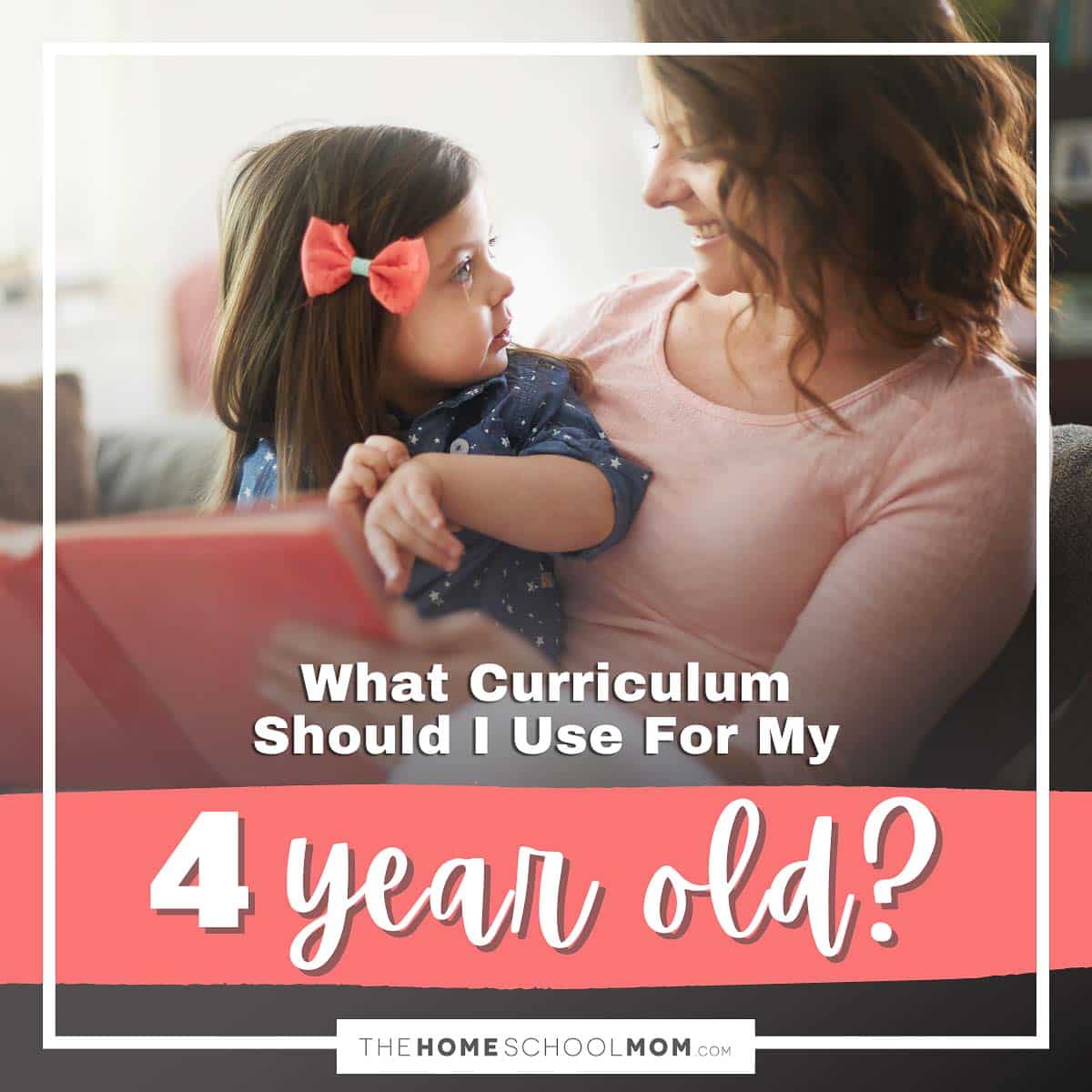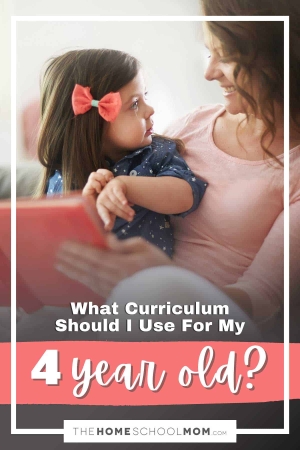Recently on TheHomeSchoolMom's Facebook page someone asked for recommendations for her soon to be 4-year-old. It took me back to when I had a 4-year-old and a 1-year-old and had recently decided to homeschool.
I. Was. So. Excited.

What curriculum should I use? (I bought KONOS and timeline figures and a gazillion Usborne books.) How should we schedule our days? (I carefully scheduled every moment of our days and then proceeded to never once use the schedule.) I made lesson plans and felt organized and believed that my kids were going to get the best education ever. And honestly, we had great fun with some of the activities - but none of it was better than what we could have done by just living and playing.
So after all these years (my kids are now grown and flown), what curriculum would I suggest for a 4 year old?
None.
The work of a 4-year-old is play. Studies show that play is how children learn. Take this time to engage your child. There will be plenty of time for setting and meeting goals later should you choose to do that (unschoolers look at goals differently), but now is the time for play.
🎲 Suggested curriculum
Here is my suggested "curriculum" for a 4-year-old (or 5-year-old or 6-year-old) that will help them develop vital skills, build your relationship with them, and give them the hooks that they need to hang later learning on:
- Read to your child. If she can read, let her also read to you. If your child is interested, extend your reading by cooking a dish that was mentioned in the book, or making a craft like one mentioned. If you are looking for something to guide you in choosing good books, I like the books used in Five in a Row for this age. If your child asks to learn to read, go for it -- but in the absence of a physical issue or developmental problem, know that waiting on reading instruction is not harmful and can even be beneficial.
- Play with LEGO® bricks. Or Lincoln Logs® , or Tinkertoys®. Or K'NEX®. Or simple wood blocks.
- Go for a walk. Listen to your child and enjoy seeing the world from her perspective.
- Go to the library. If your child can read, help him understand how the books are filed, how to use the card catalog, or have a library scavenger hunt.
- Walk in the woods. This is the perfect age to take an Alphabet Walk and learn ABCs with rocks and trees.
- Visit age-appropriate museums. Don't try this when your child is hungry, tired, or otherwise primed for unhappiness. Here are some tips for improving field trips.
- Go to the zoo. Many zoos and aquariums have annual reciprocal memberships that let you visit as many times as you like and even visit other partner zoos with your membership.
- Go to a park or play in the backyard. Just being outside helps kids achieve a natural balance between our technological world and our natural world.
- Play with maps. Let your child make a map of someplace familiar to her and have fun using just the map to find your way around. Let your child blindfold you and lead you through a maze of chairs and other obstacles that they have set up.
- Play with Play-Doh®. The benefits of messy play are many, including developing fine motor skills, encouraging creativity, allowing expression of emotions in a safe way, and stimulating language development. Make your own playdough at home if you prefer.
- Play dress up. Both boys and girls enjoy dressing up and playing or putting on their own "theatrical productions". I remember my kids continually improving a large scale production of "The Wizard of Paws" over the years.
- Dance, clap, skip, and move around. A lot. Kids are naturally wiggly and rhythm actually helps language skills.
- Play games. Board games are always fun, and strategy games like Catan Junior can be enjoyed by even young children. Building games like Jenga® can be enjoyed by all ages (and apparently many species), and strategy games like Mancala develop motor skills as well as thinking skills.
- Listen to him. Ask him "what if" questions when discussing things of interest. "What do you think would happen if this got really cold? Really hot?" "What do you think a cat would do with this?" "How deep do you think that worm goes into the ground?" Remember - you aren't asking for a right answer, you are just getting him thinking. Instead of correcting answers, encourage further discussion: "Wow, I hadn't thought of it that way! Why do you think so?" Inquiry-based learning stimulates thought processes that lead to learning.
🔎 Homeschool supplies
Jeanne shared this in response to a question that we commonly see in homeschooling groups on Facebook.
New homeschooler of littles this fall. What school supplies will I need to stock up on?"
Responses poured in on the Facebook group, from notebooks and #2 pencils to laminators and laser printers.
I love school and office supplies as much as the next person, but my mind went elsewhere.
Here are the "just starting out" school supplies I wouldn't want to do without for preschool through early elementary:
- Dress-up clothes and accessories
- Birdfeeder and birdseed
- Library card
- Modeling media: Playdoh, modeling beeswax, modeling clay, air dry clay
- Paint and art paper
- A handy bowl of manipulatives: dried pinto beans, buttons, pasta shapes
- Kids' cookbooks and smoothie recipes
- Twinkle lights and candles
- Devices to stream music and audiobooks we can listen to together
- Magnifying lenses and bug jars
- All the sticks that mark on paper: pastels, crayons, sidewalk chalk, block crayons, markers, color pencils, gel pens, feather quills
- All the paper: loose, spiral bound, journal; lined, unlined; colored, black, white; large, small, fancy and scrap
- Cozy couch to snuggle and read
- Bookbasket (beside the couch)
- Comfortable shoes for everyone
- First aid kit
- Balls: tennis, football, soccer, softball, kickball, beach ball
After twenty years of homeschooling, I can safely say that would get me through a few grades. What "less common" school supplies would you recommend to new homeschoolers? Make a list and post it on your homeschool group on social media. Save the children from a monolithic avalanche of #2 pencils!
~ Jeanne
📘 How to embrace playfulness
Let Bernie "Blue" DeKoven's free ebook A Playful Path inspire you to embrace playfulness with your children. As game designer and fun theorist, DeKoven created a book that is "jam-packed with awesomeness" says Laura Grace Weldon. "It's made up of tools and ideas to inspire the possibility-building, wide-open glory of playfulness."
The free ebook is available from DeKoven's website; a paperback copy can be purchased through Lulu.
📖 What about reading?
Defending the Early Years and Alliance for Childhood have issued a report "Reading in Kindergarten: Little to Gain and Much to Lose" showing that there is no scientific evidence that early reading makes for better readers in the long term. You can find a summary of the report in this PDF file.




 Mary Ann Kelley lives in coastal North Carolina with her husband and has two grown daughters, both homeschool and college graduates. Mary Ann, who homeschooled for almost 20 years, is a Virginia Tech graduate and lifelong learner. Mary Ann has been featured in interviews on Money.com, HuffPost, and in the Free Lance-Star newspaper. Her desire is for the content on TheHomeSchoolMom to encourage and empower parents and children to take personal responsibility for their own educational options and choices. In her free time, Mary Ann enjoys reading, traveling, genealogy, and volunteering for the Atlantic Beach Sea Turtle Program.
Mary Ann Kelley lives in coastal North Carolina with her husband and has two grown daughters, both homeschool and college graduates. Mary Ann, who homeschooled for almost 20 years, is a Virginia Tech graduate and lifelong learner. Mary Ann has been featured in interviews on Money.com, HuffPost, and in the Free Lance-Star newspaper. Her desire is for the content on TheHomeSchoolMom to encourage and empower parents and children to take personal responsibility for their own educational options and choices. In her free time, Mary Ann enjoys reading, traveling, genealogy, and volunteering for the Atlantic Beach Sea Turtle Program.
Leave a Reply